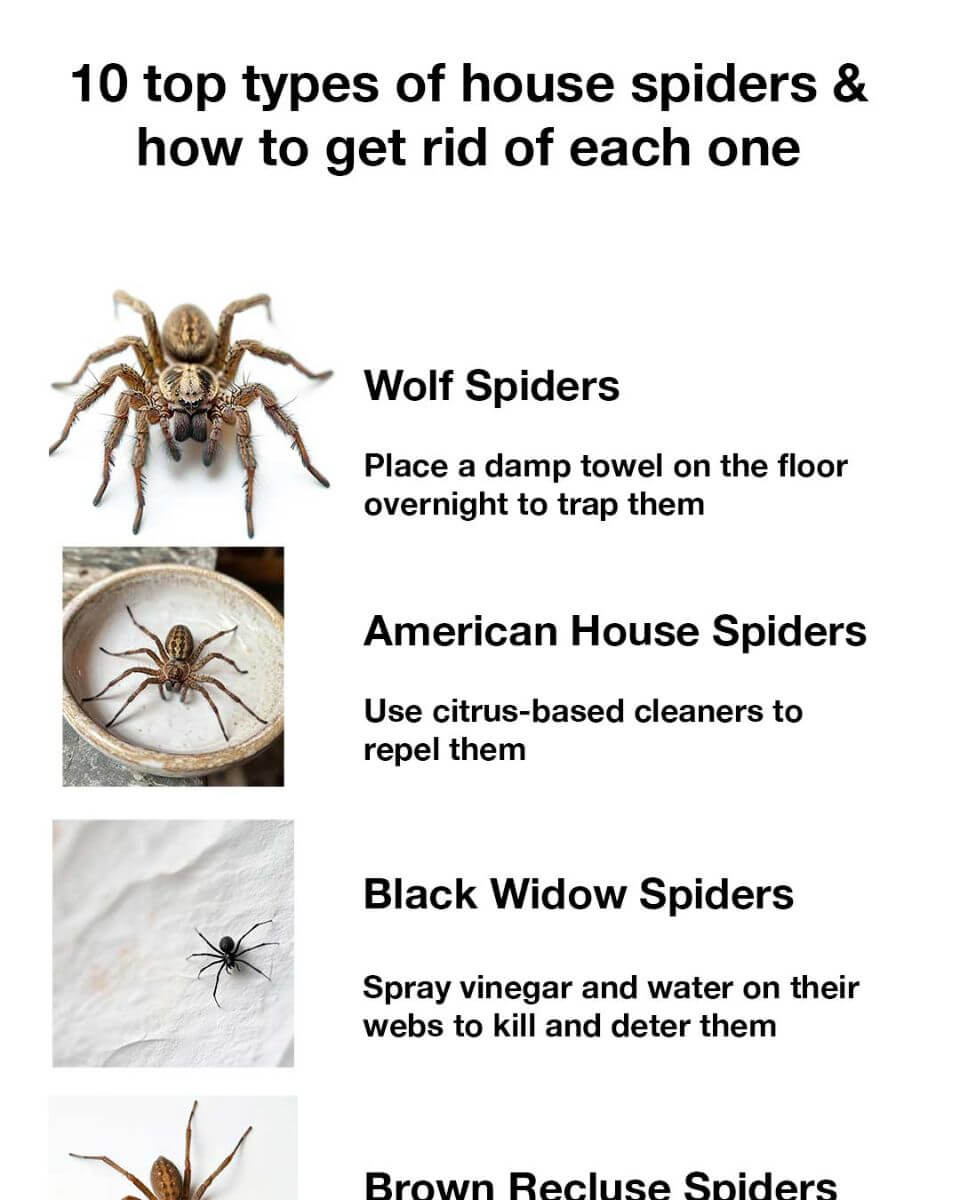Spiders are a frequent presence in homes, often making their way into corners, basements, attics, and other quiet spots. While most house spiders are harmless, many people find them unpleasant. Knowing which species you’re dealing with is the first step toward effectively managing them. This guide looks at ten common spiders found indoors, what they look like, and the best methods for removal.
Why Identifying House Spiders Matters
Properly identifying the spiders in your home is essential for several reasons. Some species, such as the black widow or brown recluse, have venomous bites that can pose health concerns. Others, like cellar spiders, are harmless and even helpful since they prey on pests. When you know what kind of spider you’re dealing with, you can decide whether removal, control, or no action at all is needed.
1. Wolf Spiders: Appearance and Where They Live
Wolf spiders are large and covered in hair. Unlike web-building spiders, they actively hunt prey. You’ll commonly find them in garages, basements, or near doors and windows. Their brown, camouflaged appearance makes them hard to detect.
How to Remove Wolf Spiders
Seal gaps around windows, doors, and your foundation. Use a vacuum to safely capture and remove any you find. Sticky traps can be placed in areas where they are often spotted. Decluttering and routine cleaning also discourage their presence.
2. American House Spiders: What to Know
These small brown spiders are known for their tangled, messy webs in quiet areas like attics, basements, and closets. They are not harmful and help control insects.
How to Get Rid of American House Spiders
Regularly dust and clean places where webs appear. Use a vacuum to remove both webs and spiders. Make sure your windows and doors are well-sealed. A clutter-free home discourages them from settling in.
3. Black Widow Spiders: Identification and Precaution
Black widows are shiny black with a red hourglass shape on the underside of their abdomen. They prefer dark, undisturbed areas such as sheds, garages, and woodpiles. Their bite can be dangerous, so care is required.
Safe Removal of Black Widows
Wear gloves and proceed cautiously when removing them. A vacuum or broom works well for their webs. For larger infestations, consider using spider-specific insecticides. Keep commonly infested areas clean and inspected regularly.
4. Brown Recluse Spiders: Dangers and Detection
These spiders range from light to dark brown and have a violin-shaped marking on their back. They hide in low-traffic areas like storage boxes, attics, or closets. Their bites can be medically serious.
Getting Rid of Brown Recluses
Cut down on clutter and close off possible entry points. Sticky traps can help monitor activity. In cases of significant infestation, contact a pest control professional. Keep frequently used areas clean to prevent them from settling.
5. Hobo Spiders: Facts and Concerns
Hobo spiders are medium-sized with a brown color and a herringbone pattern on their abdomen. Found near basements or at ground level, they were once thought to be dangerous, though they now appear to pose minimal threat.
How to Eliminate Hobo Spiders
Seal foundation cracks and small openings. Set up traps and vacuum regularly to clear away webs and egg sacs. Keeping the home dry and ventilated also makes it less inviting for them.
6. Jumping Spiders: Features and Behavior
These small spiders are compact, have excellent vision, and are known for jumping. You may find them near windows or in sunny indoor spaces. They’re curious and not harmful.
Removing Jumping Spiders
You can gently catch them with a cup and release them outdoors. Regular cleaning and dusting discourages them from staying inside. Since they help control insects, you might choose to leave them be.
7. Cellar Spiders (Daddy Long Legs): What to Expect
With long legs and small bodies, cellar spiders spin loose webs in damp, dark places like basements and crawlspaces. These spiders are not dangerous and eat other insects.
Managing Cellar Spiders
Use dehumidifiers to reduce moisture. Clean regularly and vacuum out webs. Seal off openings where they may enter. Given their helpful nature, they may not need removal unless they become a nuisance.
8. Orb-Weaver Spiders: Famous for Their Webs
These spiders are recognizable by their large, round webs often found near gardens or outdoor lights. They come in many colors and are visually distinct. Orb-weavers are harmless and help manage bug populations.
How to Control Orb-Weavers
Take down their webs using a broom or hose. Turning off outdoor lights at night can discourage them. If they’re not a problem, consider letting them remain, especially in gardens.
9. Sac Spiders: Behavior and Identification
Sac spiders are pale and build silk sacs in hidden corners or crevices. They hunt instead of weaving webs and are active all year. Bites can cause mild irritation but aren’t serious.
How to Remove Sac Spiders
Seal exterior gaps and cracks. Vacuum up spiders and their sacs. Keep clutter to a minimum and clean often. In high-activity areas, insecticides may be helpful.
10. Funnel Web Spiders: Signs and Habits
These spiders spin funnel-shaped webs in corners, storage spaces, and gardens. Usually brown or gray, they like undisturbed spots. While not dangerous, their presence can be unsettling.
Removing Funnel Web Spiders
Use a vacuum or broom to clear their webs. Close off potential entry points to prevent them from entering. Regular cleaning and removing debris inside and out will discourage them. Trim vegetation and clear away outdoor clutter.
Conclusion: Keeping Your Home Spider-Free
A spider-free home starts with prevention: regular cleaning, sealing of entry points, and keeping clutter under control. While some spiders provide benefits by reducing pests, others may be best removed due to health risks or personal comfort. With proper identification and appropriate actions, you can reduce or eliminate unwanted spider encounters in your living space.
